Doctors Blog
Injury Recovery & Your Diet
 Certain foods are crucial to help recover from an injury. When we have damaged tissue, like a torn muscle or tendon, our body needs specific nutrients to heal stronger, and faster.
Certain foods are crucial to help recover from an injury. When we have damaged tissue, like a torn muscle or tendon, our body needs specific nutrients to heal stronger, and faster.
Healthy diet > Supplements
Vitamins and minerals from a food source are SUPERIOR to taking a supplement. Healthy food offers hundreds of antioxidants, carotenoids, flavonoids, and minerals not found in supplements! Additionally, when we eat a health diet, our body automatically maximizes absorption of "the good stuff", and eliminates what we don't need. Taking supplements can result in extremely high, or toxic, levels of vitamins, which can be harmful.
Assess your diet FIRST before taking supplements to ensure your body is getting what it needs to heal.
You are... what you drink?
 ~50% of our body composition is water~
~50% of our body composition is water~
We've all heard the cardinal rule for daily water consumption... "Adults need 6 to 8- 8oz glasses of water". But this isn't personalized for you or your activity level. YOUR WEIGHT determines your body's need. Other factors to consider are activity level, outside temperature, pregnancy, diet, and medications/health conditions.
Here's a more personalized way to estimate how much water YOU should be drinking:
- Take your weight (in lb) and multiply by 0.5. That number is the minimum ounces you should be drinking per day.
- For every 30 minutes you exercise, add 12 oz.
Example: 150lb x 0.5= 75oz
Exercise for an hour= (60min/30min) x 12oz= 24oz
Recommended: 99oz of water
Signs of dehydration include: dry mouth, headache, muscle cramps, dark or strong smelling urine.
Talk to a medical professional if you have questions about your hydration level.
Benefits of Aquatic Therapy
 Are YOU working through an injury or rehabbing after surgery? Need a rest day as a competitive athlete?
Are YOU working through an injury or rehabbing after surgery? Need a rest day as a competitive athlete?
Aquatic/Water therapy provides numerous benefits:
- Increases circulation and decreases swelling. In water, hydrostatic pressure and increased mobility combine to help improve blood flow and decrease swelling.
- Reduces pain and muscle spasms. Hydrostatic pressure of water provides compression during water therapy. With muscles stimulated underwater, the body relaxes and exercises are more comfortable to perform.
- Less stress on affected bones, muscles and tendons. Buoyancy of water makes patients up to 80% lighter! Without the stress of gravity, the body is more relaxed and exercises can be performed more easily.
Aquatic therapy is a MUST for athletes and HIGHLY RECOMMENDED for patients recovering from injuries or rehabilitating after surgery.
Find out if it's safe for you to incorporate aquatic therapy into your routine.
The Secret about Surgical Scars
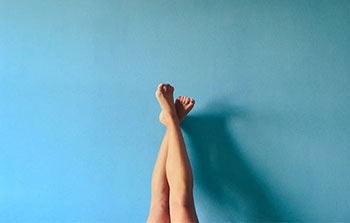 Believe it or not, there is ZERO hard scientific evidence backing scar management with creams, ointments, patches, lasers, retinol, steroids, and more. It's a 22.5 billion dollar industry (2022) for good reason...Most people want to avoid unsightly scars!
Believe it or not, there is ZERO hard scientific evidence backing scar management with creams, ointments, patches, lasers, retinol, steroids, and more. It's a 22.5 billion dollar industry (2022) for good reason...Most people want to avoid unsightly scars!
Your body's ability to heal an incision is largely determined by:
- Your genes
- Surgeon technique
So what to do?
- Pick a surgeon you trust, and who cares about what your scar looks like. Ask them about their technique!
- Follow your surgeon's post-operative instructions. Ask questions!
- MY RECOMMENDATIONS at 3 weeks post-op (EVIDENCE-BASED, BACKED BY SCIENCE):
- Initiate pressure therapy with a compression sleeve, sock, or bandage. Pressure helps regulate collagen synthesis, and is believed to decrease fibroblast activity, decreasing scar height.
- Apply petrolatum (41%) morning, noon, and night to your incision for 8 weeks. This ointment keeps the wound from drying out, speeding up healing.
- Start scar mobilization techniques with help of physical therapy at 4 weeks. Mechanical stimuli on a scar initiates mechanotransduction- cells sense a stimulus and convert it into biochemical signals, effectively influencing the cross-linking of collagen fibers. It helps increase the pliability of the skin, helping it to move and appear like "normal".
The BEST thing you can do to maximize your body's ability to heal is to eat a healthy, well-balanced diet and drink plenty of water. It will keep your cells happy and functioning properly.
Why Compression is essential for your Recovery
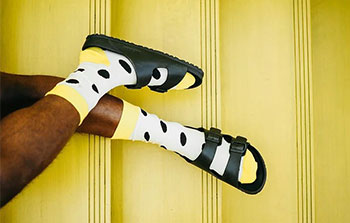 Compression garments (CGs), such as socks, sleeves, shorts, etc., have been investigated for years to elucidate health benefits.
Compression garments (CGs), such as socks, sleeves, shorts, etc., have been investigated for years to elucidate health benefits.
What YOU should know:
- CGs reduce the severity of delayed-onset muscle soreness and exercise-induced muscle damage by increasing venous blood flow velocity and lymphatic outflow.
- CG users are reported to have lower levels of creatine kinase, a marker of muscle damage, and lactate than non-CG users.
Use of compression during and after exercise can:
- IMPROVE pain scores
- DECREASE perceived soreness
- REDUCE overload/overuse injuries
For patients recovering from surgery, CGs promote circulation, reduce swelling, and decrease risk of blood clots (DVT).
We can ALL benefit from compression garments. Talk to a healthcare professional today about how COMPRESSION can help you!
Can Carbon Fiber Insoles help you?
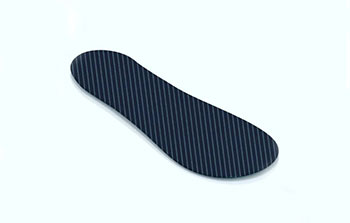 Your toes BEND during sports, exercise, or performing daily activities helping maximize your propulsion or push off strength. How far your toes bend can be determined by what you have on your feet (or in your shoes)!
Your toes BEND during sports, exercise, or performing daily activities helping maximize your propulsion or push off strength. How far your toes bend can be determined by what you have on your feet (or in your shoes)!
Shoe bending stiffness, or longitudinal bending stiffness= how easily a shoe can bend.
Think of a minimalist shoe. Lightweight, little to no cushion or stability, and super flexible.
Next, think of a traditional running shoe. Slightly heavier, more cushion and stability, less flexibility. ~GREATER BENDING STIFFNESS~
It’s reported that increasing the longitudinal bending stiffness of a shoe DECREASES energy expenditure until a low point is reached. This suggests that there is an OPTIMAL SHOE STIFFNESS, which is also based on YOUR ANATOMY, SPORT, ACTIVITY LEVEL, and COMFORT.
A rigid carbon fiber footplate that runs the length of your shoe reduces the bending moment at the toe joints, which is believed to reduce energy expenditure (in certain conditions). Additionally, a carbon fiber insert lengthens the foot as a lever arm, which increases the power of the entire lever. #biomechanics
Remember: Every athlete is different! What works for one athlete, may not work for you. There is no “one size fits all” solution when it comes to shoe gear OR performance equipment. This is a growing area of research, so stay tuned!
Vitamin D: Are you getting enough?
 Did you know that GLOBALLY 50% of the population receives insufficient Vitamin D?!?!
Did you know that GLOBALLY 50% of the population receives insufficient Vitamin D?!?!
Studies show 80% of our Vitamin D comes from UV-B rays from SUNLIGHT (!) and 20% from our diet.
Vitamin D is ESSENTIAL for the absorption of Calcium... and maximizing bone health! What can YOU do to maximize your Vitamin D intake and keep your bones strong and healthy?
1. Get regular physical exercise indoors and outdoors.
2. Get 10-15 minutes of exposure to sunlight each day.
3. Eat a healthy, well-balanced diet that includes foods rich in Vitamin D (fatty fish, mushrooms, egg yolks, and fortified foods such as cereals, orange juice, low-fat dairy, and plant-based milk alternatives)
4. Take a supplement if you aren't getting adequate intake (talk to a medical professional for recommended dosing).
Patients often ask HOW MUCH Vitamin D they should be getting. A healthy level of Vitamin D for both children and adults is between 40-60ng/mL. If you have a bone injury, like a stress fracture, or recently underwent surgery, your preferred level may be closer to 60ng/mL. Most physicians would agree that levels under 30ng/mL are "insufficient." Fatigue, difficulty sleeping, depression, hair loss, and muscle weakness/cramps are just a few symptoms of Vitamin D deficiency.
***Ask a medical professional for help determining if you should be tested for a deficiency or require supplementation.***
Increasing rate of Stress Fractures
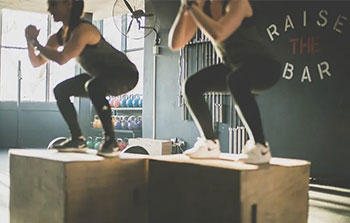 Stress fractures are overuse injuries, related to intense training, sudden increase in activity level, and repetitive movement patterns. Other related factors can be wearing worn out shoes or the wrong shoe type, poor technique, insufficient rest, and changes to the surface you're performing on. The prevalence of stress fractures is on the rise, especially in young athletes and adults beginning new workout routines after periods of inactivity.
Stress fractures are overuse injuries, related to intense training, sudden increase in activity level, and repetitive movement patterns. Other related factors can be wearing worn out shoes or the wrong shoe type, poor technique, insufficient rest, and changes to the surface you're performing on. The prevalence of stress fractures is on the rise, especially in young athletes and adults beginning new workout routines after periods of inactivity.
What is a stress fracture? It's a weakened area in the bone due to microscopic tears. Without proper treatment, the tears can progress into a complete fracture.
Common symptoms:
- Pain with activity that subsides with rest
- Swelling in the area of injury
- Tenderness with pressure on the bone
It's important to seek treatment from a medical professional if you suspect a stress fracture. Prompt diagnosis, treatment, and rehabilitation can help keep you moving and prevent further injury.
Pregnancy & Your Feet
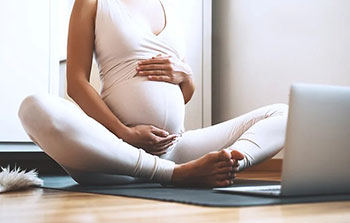 One of the most common complaints during pregnancy is foot pain and swelling. Both are very normal and extremely common. Read on to learn more about what the heck is going on, and how to stay comfortable!
One of the most common complaints during pregnancy is foot pain and swelling. Both are very normal and extremely common. Read on to learn more about what the heck is going on, and how to stay comfortable!
During pregnancy, your body increases circulation of certain hormones, like relaxin, which cause ligamentous laxity.
Your feet may widen, lengthen, and become painful from the stretch in your ligaments and loss of structural support. To prevent discomfort from these changes, wear supportive shoes at all times. Over-the-counter insoles or custom orthotics can help provide the arch support and cushion you need. Wide toe box athletic shoes and open toed, but supportive, sandals can help accommodate your growing feet. (Spoiler alert: your feet may never go back to their pre-pregnancy size.)
As your baby grows, your center of gravity changes, increasing the pressure on different areas on the bottom of your feet.
Protect yourself from heel pain and plantar fasciitis throughout your pregnancy by paying attention to the type of shoes you wear. Early in your pregnancy, your weight increases but your center of gravity hasn't shifted much. Shoes with padding in the ball of your feet will help accommodate the increased pressure from weight gain. Look for shoes with more substantial heel cushioning later on in your pregnancy, when your center of gravity moves backward, shifting pressure to your heels.
As your baby grows, your body holds more fluid, but also becomes less efficient at filtering and moving fluid throughout the body, leading to swelling. Here are recommendations for keeping your swelling in check throughout your pregnancy:
- Wear compression socks. Graduated compression is best, and avoid styles with a tight band at the top of the calf. Put them on first thing in the morning, before you start your day.
- Avoid standing for long periods of time. Prop up your legs without crossing them when lounging. The best position for quick relief later in pregnancy is to lie down on your left side with your legs slightly elevated.
- Try to exercise. If you have access to a pool, aquatic therapy helps reduce swelling and back pain!
- Keep cool. Try soaking your feet in cold Epsom salt bath or similar to provide some relief.
- Massage your feet and roll your ankles throughout the day. Try to massage UP the leg to decrease swelling.
- Stay hydrated. If your body thinks you're not getting enough water, it will retain more!
- Refrain from sleeping on your back during the third trimester. The weight of your baby compresses a large vein that slows your circulation, worsening swelling.
- Decrease salt intake (sorry!)
Notify your doctor when:
- You have pain only on ONE side.
- Sudden onset of swelling inconsistent with your typical "end of day" swelling.
- Swelling in only ONE leg.
Why Dynamic Warm-ups Improve Performance and Reduce Injuries
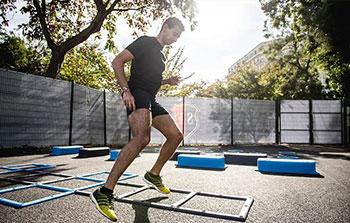 Modern research tells us that "old school" static stretching doesn't cut it before sports or intense exercise. We now know that dynamic stretching is the key to improving agility, speed, performance and decreasing injuries.
Modern research tells us that "old school" static stretching doesn't cut it before sports or intense exercise. We now know that dynamic stretching is the key to improving agility, speed, performance and decreasing injuries.
Benefits of a Dynamic Warm-Up:
- Increases heart rate and blood flow ➡️ more oxygen and nutrients available for muscles to use
- Increases core body temperature ➡️ lower tissue viscosity, increased muscle elasticity, increased range of motion, and more forceful muscle contraction
- Simulates nervous system ➡️ primes neural pathways to improve your coordination and movement
Dynamic warm-ups decrease injury by prepping your body for the work. Sensors in your muscles start sending signals to your brain to communicate their needs. This results in increased responsiveness, so your body is primed for peak performance. Tailor your dynamic warm-up to your sport or activity so that the proper muscle groups are turned on and ready to go.
Is there still a place for static stretching? Yes. Incorporate slow, static stretching into your cool down routine.
More...
Benefits of Practicing Yoga
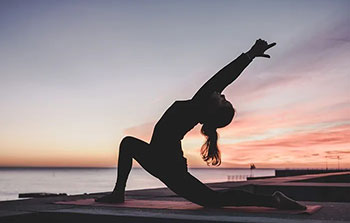 A routine yoga practice can reel in benefits like:
A routine yoga practice can reel in benefits like:
- Increased endurance, flexibility & muscle strength
- Improved core strength, athletic performance & balance
- Injury prevention
- Mental relaxation & focus, and more!
There IS something for everyone... from simple stretches to advanced power poses.
Got a desk job? Focus on your posture with seated twists, shoulder rolls, wide-leg forward bend, seated figure 4 stretch, seated backbend stretch, seated crescent moon, stork pose, wrist rolls. Or start with this video.
Commute much? Try these seat-friendly stretches when you're at your destination: Seated mountain pose, seated cat/cow pose, seated cobra pose, seated spinal twist, neck rolls, seated forward fold, and anterior shoulder stretch.
Need more cardio? Try power yoga vinyasas that include chaturanga dandasana, warrior poses, and arm-balancing poses.
Constantly stressed? Check out restorative yoga and use props to help you relax, clear your mind, and decompress.
Not sure what's right for you? Learn more about different yoga practices here.
Tips for beginners:
- Breath. Pay attention to your breath and breathe deeply. Fill up your lungs! Inhale when opening the front of the body, and exhale when compressing the front of the body. (Or follow your instructor!)
- Slow down. Focus on intentional movement.
- Listen to your body. Make modifications if something doesn't feel right. Start with beginner poses and work your way up to advanced.
Get started today and feel the benefits of yoga for yourself!
Foot Cramps 101
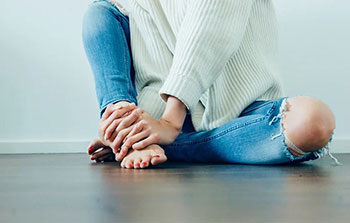 What are they?
What are they?
Foot cramps are a common, involuntary muscle spasm with a sharp or deep aching sensation, lasting seconds, minutes, or even days. Common causes include:
- Dehydration
- Overuse/ overexertion
- Prolonged sitting or standing
- Pregnancy
- Tight footwear
- Electrolyte imbalances/ poor diet
How to manage:
- Apply heat to increase blood flow, improve flexibility and relax muscles.
- Stretch slowly to help alleviate symptoms.
- Massage the affected area to increase blood flow and decrease lactic acid buildup.
- Wear supportive shoes that are properly sized with space to wiggle toes.
- Stay hydrated! Drink water throughout the day.
- Eat a healthy, balanced diet to provide adequate vitamins, minerals, and nutrients to your body.
Foot cramps may also be a sign of nerve damage or an underlying health condition. Some medications have side effect profiles that include cramping. Talk to your healthcare provider if your foot cramps aren't improving.
Surprising causes of leg cramps
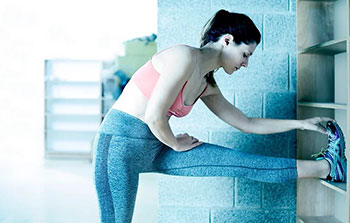 Leg cramps are more common than you think. Some reasons you may be familiar with, but others might surprise you:
Leg cramps are more common than you think. Some reasons you may be familiar with, but others might surprise you:
- your weight
- dehydration/ low levels of electrolytes
- lack of blood flow
- nerve compression
- pregnancy
- under-training / overexertion
- medications (diuretics, NSAIDs, statins, birth control pills, and more)
- medical conditions involving your kidneys, thyroid, liver, circulation, and more
Suggestions for prevention:
- Check your weight. If you're over a healthy weight and need help putting together a weight-loss plan or diet, talk to your doctor. We're here to help!
- Drink enough water. Check out my blog post on personalized water consumption: https://www.ezfootankle.com/post/you-are-what-you-drink
- Warm up with dynamic movements and stretching before exercise. Heat can be applied during/after cramping episodes to help increase blood flow and relax the muscle while stretching.
- Focus on proper training, form, and getting adequate rest. Muscle imbalances can also cause cramps, so be sure your training regimen is balanced (agonist/antagonist, eccentric/concentric, etc.)
- Replace electrolytes! Replenish through foods like low-fat yogurt, bananas, spinach, and lentils. Increase your intake of vitamin D, B (1 & 12), magnesium, zinc, and potassium. Sports drinks (low sugar options!) and supplement powder forms are convenient options.
To treat:
- Stop the movement that triggered the cramp
- Apply heat + gently stretch or massage the area
- Hydrate and replace electrolytes. (Pickle juice can work in a pinch!)
- Once the cramping episode subsides, continue to work on stretching and massaging that area over the next 24 hours.
- Work on prevention tips above!
If you're taking any medications that increase the risk of muscle spasms or cramps, talk to your doctor about options including switching to a different medication, changing your dose schedule, or re-evaluating its necessity. If you're experiencing cramping that persists despite lifestyle changes, or start to experience muscle weakness, skin color changes, leg swelling, increase in frequency of cramps, or severe pain, it may be a sign of something more serious and you should seek medical care immediately.
Back pain: How shoes affect your Spine
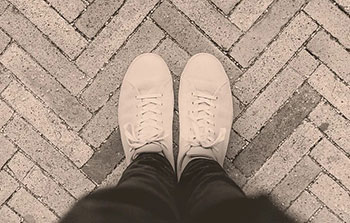 The normal curvature of your spine functions to dissipate ground reactive forces (Newton's 3rd law #biomechanics). If your center of gravity changes due to an abnormal gait pattern, inadequate support, or lack of shock absorption, the spine can no longer disperse forces effectively, and your spinal curvature adapts. This adaptation, or malalignment, causes back pain.
The normal curvature of your spine functions to dissipate ground reactive forces (Newton's 3rd law #biomechanics). If your center of gravity changes due to an abnormal gait pattern, inadequate support, or lack of shock absorption, the spine can no longer disperse forces effectively, and your spinal curvature adapts. This adaptation, or malalignment, causes back pain.
Your center of gravity shifts as you walk from heel to toe, evenly distributing your weight through the feet. Normal walking mechanics are achieved with footwear that supports your body weight. Without proper support, your center of gravity is thrown off, causing an abnormal gait, leading to stress and strain up the kinetic chain (from your feet up to the spine). Good posture and proper alignment & support keeps the body happy and pain-free.
Final thoughts:
- Shoes should contain a shock absorptive material to help disperse forces from the ground as you walk, run, jump, or participate in activities. Many thin, flimsy flip flops don't provide this layer of protection, which is why you may experience pain after hours of wearing this type of unsupportive shoe. If you wouldn't want to wear the shoes to walk a mile, you probably shouldn't be wearing them at all!
- High heels change our center of gravity, increasing our spinal curvature (hyperlordotic lumbar spine) causing back pain. When you feel it's absolutely necessary to wear heels, limit your heel height to 1-2 inches and always bring a pair of comfortable shoes to change into.
- Flat shoes (ballet flats, flip flops, etc.) lack proper support, shock absorption, and also require your toes to flex or pinch to keep them on your feet. This shortens your stride, affects your center of gravity, again leading to back pain.
Your feet are your foundation. Your shoes affect more than just your feet they impact your ankles, knees, hips, and spine. If you experience back pain, the first place to look is down!
